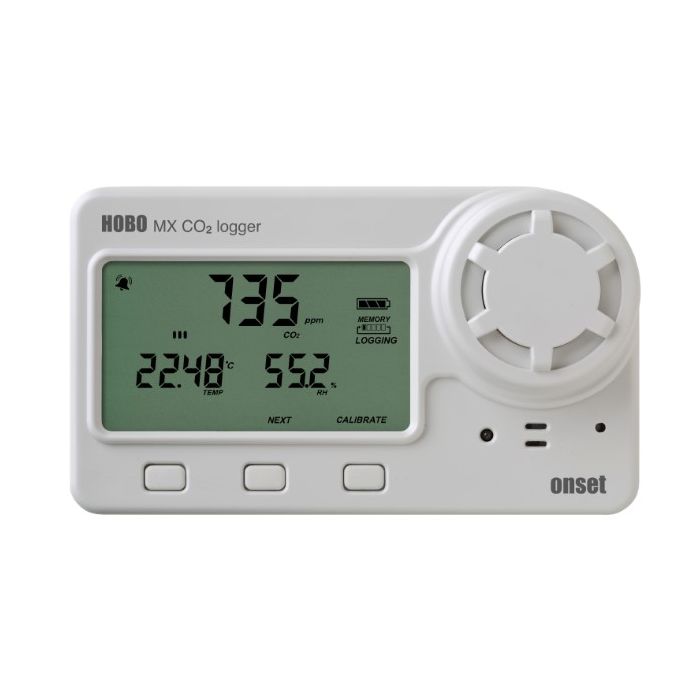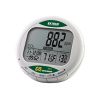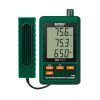HOBO MX Carbon Dioxide/Temp/RH Data Logger
Features
- Measurement range, 0-5,000 ppm
- Self-calibrating NDIR CO2 sensor technology
- Access data by mobile phone, tablet or computer within 100ft of logger
- Expedited repair and warranty service
- Lifetime technical support
- More
Overview
The HOBO MX1102 CO2 logger makes it more convenient than ever to measure and record CO2 in buildings and other non-condensing environments. It measures CO2 from 0–5,000 parts per million (ppm). The free HOBOconnect app allows users to access data right from a mobile phone or tablet within a 100-foot range. Remotely access data via LI-COR Cloud IoT software (formerly HOBOlink) with the new MX Gateway.
Mechanics
The MX1102 also features a USB port, so it can be used with a computer running HOBOware Pro graphing and analysis software.
| Temperature Sensor | |
| Range | 0° to 50°C (32° to 122°F) |
| Accuracy | ±0.21°C from 0° to 50°C (±0.38°F from 32° to 122°F) |
| Resolution | 0.024°C at 25°C (0.04°F at 77°F) |
| Drift | <0.1°C (0.18°F) per year |
| RH Sensor | |
| Range |
1% to 90% RH (non-condensing) |
| Accuracy | ±2% from 20% to 80% typical to a maximum of ±4.5% including hysteresis at 25°C (77°F); below 20% and above 80% ±6% typical |
| Resolution | 0.01% |
| Drift | <1% per year typical |
| CO2 Sensor | |
| Range | 0 to 5,000 ppm |
| Accuracy |
±50 ppm ±5% of reading at 25°C (77°F), less than 90% RH non-condensing and 1,013 mbar |
| Warm-up Time | 15 seconds |
| Calibration | Auto or manual to 400 ppm |
| Non-linearity | <1% of FS |
| Pressure Dependence | 0.13% of reading per mm Hg (corrected via user input for elevation/altitude) |
| Operating Pressure Range | 950 to 1,050 mbar (use Altitude Compensation for outside of this range) |
| Compensated Pressure Range | -305 to 5,486 m (-1,000 to 18,000 ft) |
| Sensing Method | Non-dispersive infrared (NDIR) absorption |
| Response Time | |
| Temperature | 12 minutes to 90% in airflow of 1 m/s (2.2 mph) |
| RH | 1 minute to 90% in airflow of 1 m/s (2.2 mph) |
| CO2 | 1 minute to 90% in airflow of 1 m/s (2.2 mph) |
| Logger | |
| Radio Power | 1 mW (0 dBm) |
| Transmission Range | Approximately 30.5 m (100 ft) line-of-sight |
| Wireless Data Standard | Bluetooth Smart (Bluetooth Low Energy, Bluetooth 4.0) |
| Logger Operating Range | 0° to 50°C (32° to 122°F); 0 to 95% RH (non-condensing) |
| Logging Rate | 1 second to 18 hours |
| Logging Modes | Fixed interval (normal, statistics) or burst |
| Memory Modes | Wrap when full or stop when full |
| Start Modes | Immediate, push button, date & time, or next interval |
| Stop Modes | When memory full, push button, date & time, or after a set logging period |
| Time Accuracy | ± 1 minute per month at 25°C (77°F) |
| Power Source | 4 AA 1.5 Volt batteries (user replaceable) or USB power source (5 V DC, 2 Watts) |
| Battery Life | 6 months, typical with logging and sampling intervals of 5 minutes or slower; 6 months or less with logging and sampling intervals faster than 5 minutes while logging CO2. Entering burst logging mode will impact battery life. With app use, battery life can be reduced by remaining connected, excessive readouts, audible alarms, and paging. Visual/audible alarms and other events can have a marginal impact on battery life. |
| Memory | 128 KB (84,650 measurements, maximum) |
| Download Type | USB 2.0 interface or via Bluetooth Smart |
| Full Memory Download Time | 20 seconds via USB; approximately 60 seconds via Bluetooth Smart, may take longer the further the device is from the logger |
| LCD | LCD is visible from 0° to 50°C (32° to 122°F); the LCD may react slowly or go blank in temperatures outside this range |
| Size | 7.62 x 12.95 x 4.78 cm (3.0 x 5.1 x 1.88 inches) |
| Weight | 267.4 g (9.43 oz) |
| Environmental Rating | IP50 |
- HOBO MX1102 CO2 Data Logger
- Four AA 1.5 V alkaline batteries
In The News


























